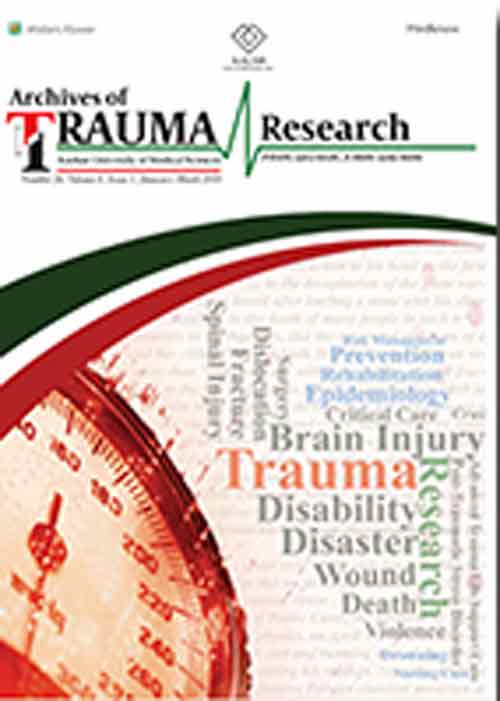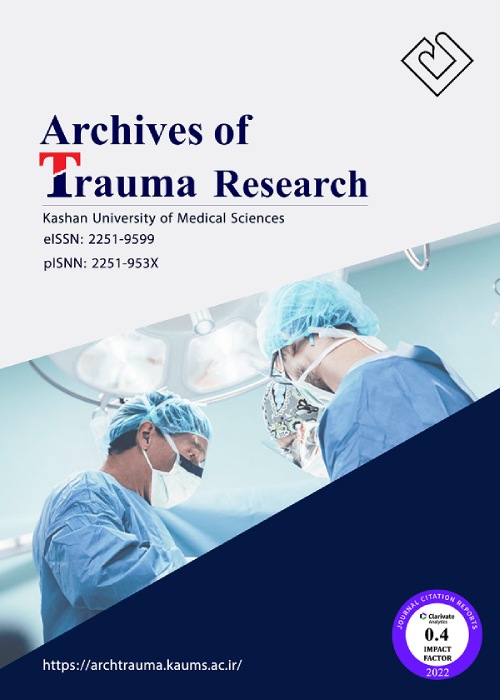فهرست مطالب

Archives of Trauma Research
Volume:8 Issue: 1, Jan-Mar 2019
- تاریخ انتشار: 1398/07/10
- تعداد عناوین: 8
-
-
Pages 1-5
In this systematic review, we detailed the current understanding and controversies on venous thromboembolism as the sequel following traumatic brain injury (TBI). The review was conducted on the literature survey to find the thromboembolic morbidities in TBI patients. This review presented the thromboembolic sequel of patients with TBI by a comprehensive focused assembly of research publications by searching various resources. A search strategy with specific inclusion criteria was performed in PubMed, Cochrane, Web of Science, and the WHO Global Health Library. TBI is related with the incremental presence of spectrum of thromboembolic disorders from primary and secondary injuries by the significant increases in the concentrations of the initiating factors of the coagulation cascade. The incidences of thromboembolism vary on factors like the severity of TBI, methods of prophylaxis used or the processes to diagnose embolic involvement. The most effective time for the initiation of antithrombotic therapy chemoprophylaxis should be initiated after 24 h or after 72 h in patients with brain trauma is still a controversial issue. Patients with brain injury are at increased risk for thromboembolism for which prophylaxis and timely management are highly recommended, and this should be available in all levels of care.
Keywords: Sequel, traumatic brain injury, venous thromboembolism -
Pages 6-10Background
The aim of this study was to compare the outcome of splenic hilum ligation (SHL) and splenectomy in spleen trauma in rat model.
MethodsThis interventional study was performed on 38 rats with spleen injuries. Rats were randomly divided into SHL and splenectomy groups. After 7 days of surgery, IgG, IgA, IgM, and IgE were measured. At this time, blood smear was prepared to evaluate Howell–Jolly bodies, target cells, schistocyte, poikilocyte, and anisocyte. Three months after the surgery, the spleen viability was evaluated by relaparotomy.
ResultsAfter 7 days, white blood count was significantly lower in SHL group as compared to control group (P = 0.024). All variables in peripheral blood smear were significantly lower in SHL group as compared to control group, except Howell–Jolly bodies (P = 0.461). In the SHL group, all spleens were viable in second operations.
ConclusionsSHL can be used safely in the management of traumatic splenic injuries in rats.
Keywords: Hilum ligation, nonoperative management, splenic injuries -
Pages 11-16Background
All the trauma scoring systems (TSSs) have some limitations, and none is useful for patient monitoring. Recently, investigators have tried to modify the TSSs to improve their use.
AimsThis study was conducted to determine whether any correlation exists between dysoxia metabolism markers (DMMs), including venous base deficit (BD) and HCO3 level with different TSSs.
Materials and MethodsIn this cross‑sectional study, all multiple trauma patients admitted to the emergency department were eligible. Blood samples for venous blood gas analysis were taken at the onset of resuscitation process. TSSs, including trauma index (TI), abbreviated injury score (AIS), Injury Severity Score (ISS), Revised Trauma Score (RTS), and Trauma Score‑ISS (TRISS), were calculated for the patients. Spearman’s rank correlation coefficient test was applied to find the association between the independent variables.
ResultsA total of 285 patients with a mean age of 33.37 ± 15.29 fulfilled the inclusion criteria, of which, 211 cases (74.0%) were male. Statistical analysis revealed that there was a correlation between TI and HCO3 level (P = 0.0001, r = −0.37) and also TI and BD (P = 0.0001, r = −0.47). Furthermore, there was an indirect correlation between AIS and ISS with HCO3 and BD levels and the direct correlation between RTS and TRISS with HCO3 and BD levels.
ConclusionIt is likely that there is a statistical correlation, although weak, between TSSs with DMMs, including HCO3 and BD level.
Keywords: Acid‑base imbalance, correlation of data, hemodynamic monitoring, trauma severity indices -
Pages 17-22Background and Objectives
Road traffic accidents (RTAs) are the second cause of death, the first leading cause of years of life lost due to premature mortality, and the most common source of injury in Iran. According to the World Health Organization estimates, Iran located in the countries that have the highest rates from RTAs. The present study aimed to measure road traffic mortality rates and also to depict a view of the trend for a period of 11 years which started from 2006 to 2016.
Materials and MethodsIn this cross‑sectional study, we collect data on all road traffic deaths in Iran between 2006 and 2016 using records from the Legal Medicine Organization. For doing this research, demographic and epidemiological data of the deceased were extracted using a checklist designed by the forensic experts. Content validity of this form was determined by obtaining comments of professors and scholars in the field. Directly standardized mortality rates were calculated. Finally, the information was analyzed by descriptive statistics.
ResultsDuring the 11‑year period of this study, 226,514 people in Iran died from RTAs. The age‑adjusted mortality rate that caused by road traffic decreased from 41.5/100,000 people in 2006 to 20.4 in 2016 during the study period. There were significant differences in mortality rates between males and females and between outside city and inside city roads. The age‑adjusted mortality rate was significantly higher among men than in women. The majority of death has occurred in illiterate young men aged 15–34 years and also in self‑employed people.
ConclusionsDuring the 2006–2016, mortality from RTAs decreased from 41.5 to 20.4/100,000 populations. This decreasing trend was observed in both sexes and in outside city and inside city roads. However, this reduction trend in the last years of the study is not suitable. These findings highlighted that training programs and harm reduction approaches for reducing the mortality from traffic accident are still needed.
Keywords: Accidents, Iran, mortality, traffic, trend -
Pages 23-27Background
Road accidents and casualties resulted are among the current challenges of human societies, which have imposed a high cost on the economies of countries.
ObjectivesPrediction of accidents caused by driving incidents helps planners achieve a suitable model to reduce the occurrence of traumas resulted from the driving accidents.
Materials and MethodsIn this study, a seasonal time series model was used for predicting the number of road accident traumas. Data related to the patients referring to Imam Khomeini Hospital in Ilam Province were evaluated from March 2012 to June 2017.
ResultsThe results showed that during November and October in 2015 and 2016, we had the highest number of accidents due to high traffic during New Year’s Vacation, summer trips, and religious pilgrimages including the Arbaeen. Moreover, the results depicted that the seasonal Arima model was effective in predicting the number of traumas due to accidents. Furthermore, forecasting the model showed an ascending trend in the number of accidents in the following 3 years.
ConclusionThe number of accident traumas in the forthcoming months can be predicted through time series models. Of course, these models can be used by managers as appropriate tools for traffic analysis. Furthermore, the increasing trend in the number of traumas indicates that serious consideration for planning and managing such events seems necessary for the administrators in the near future.
Keywords: forecasting, interrupted time series analysis, traffic -
Pages 28-32Background
Warfare is an immense destruction of human life and infrastructure. Wide‑scale trauma is a gigantic problem, and the latest war trends are toward targeting more civilians. Injuries in war are multifactorial depending mostly on arms engaged. The objective of this study was to examine the characteristics of extremity injuries in the Iran–Iraq war. The important principle is recognizing injury types, mechanism of trauma, and factors influencing complications in extremity injuries of war.
MethodsIn this retrospective study, we reviewed documents of 8437 patients who were transported and treated in Imam Khomeini Hospital, Tehran, during 8‑year Iran–Iraq war from 1980 to 1988. 7352 patients with physical injuries were selected as a sample. Data collection form included type, mechanism, and location of the injury, associated lesions, and the treatment given. Data were analyzed by descriptive statistics (frequency and mean) using SPSS software.
ResultsMedical archive review identified 8437 patients, 7352 sustaining physical trauma and 4926 among them had 6601 extremity injuries. Mean age of the patients sustaining extremity injury was 23 years. 74% (4885) of the injuries were caused by shrapnel fragments, 12% (792) were caused by bullets and rest 14% were due to various other causes. There were 53.9% (3561/6601) fractures among the total injuries, most commonly involving femur (19.9%). Fracture fixation with 66.3% (1394/2103) was the most common type of orthopedic treatment provided. In addition, 20.6% (1359/6601) injuries were related to arterial lesions and 32% (2112/6601) were accompanied with nerve damage.
ConclusionExtremity injury is a major trauma in war zones and leads to high rate of morbidity; however, if appropriate care and timely assistance are provided, it has low risk of death. Understanding type, frequency, and mechanism of injury and factors influencing trauma is of extreme importance in appropriate management and avoiding unnecessary amputations.
Keywords: Extremity injuries, Iran–Iraq war, trauma management, warfare -
Pages 33-40Background
In many developed and developing countries, a significant proportion of deaths from road traffic accidents occur in the passages within cities. Considering the importance of this issue, this study was conducted to determine the environmental factors affecting the frequency of deaths in 22 areas of Tehran.
Materials and MethodsIn this study, the statistical population consisted of traumatic traffic incidents during the period of 2014–2016, all of which were studied. The data necessary for conducting the study were extracted from the traffic police databases, Tehran Municipality, and the Statistics Center of Iran. In order to analyze the role of regional and environmental factors in the frequency of traffic accidents related to pedestrians in geographic units (22 districts of Tehran), the Poisson regression and geographically weighted regression models were used. The likelihood ratio test was used to compare the models. The goodness‑of‑fit of models was evaluated using R2, Bayesian information criterion, and Akaike’s information criterion statistics.
ResultsIn this study, 519 incidents were studied, 175 of which (33.7%) were related to motorcyclists, 174 (33.5%) related to automobile drivers, and 170 (32.8%) pedestrians. The frequency distribution of the incidents studied varied in Tehran’s 22 districts. The incidence of accidents in the central regions of Tehran was lower, while marginal areas located in the north, south, east, and west of Tehran had the highest frequency of fatal accidents. The both final Bayesian Poisson and GWR models showed that the relationship between the length of highways and educational land used with dependent variable was statistically significant.
ConclusionVarious demographic and environmental variables play a role in determining the distribution pattern of these types of events. Through regional planning, proper traffic management, controlling environmental risk factors, and training people the pedestrian safety in Tehran can be improved.
Keywords: Environmental factors, geographic information system, statistical models, traffic accidents -
Pages 41-44
Sacroiliac joint dislocation is an uncommon and potentially life‑threatening injury secondary to high‑energy trauma. Given that bilateral sacroiliac joint dislocation has rarely been reported, its management constitutes a clinical challenge. The aim of this study was to review the literature available about sacroiliac joint dislocation management and to show an effective and reliable method to treat this kind of injury. Case report. We present a 15‑year‑old female patient who suffered a complete bilateral sacroiliac joint dislocation. The definitive treatment consisted of bilateral L4‑iliac assembly plus right sacroiliac screw assisted by an O‑arm navigation system. Surgical instrumentation allowed mobilization and full‑weight‑bearing a few days after surgery. At the 2‑year follow‑up, the patient remained asymptomatic. The triangle fixation technique stabilizes the sacroiliac joint and binds the lumbar spine to the pelvis. This method could represent a good option that allows early mobilization and weight‑bearing.
Keywords: Iliac posterior instrumentation, O‑arm navigation, sacroiliac joint dislocation, unstable pelvic fractures


